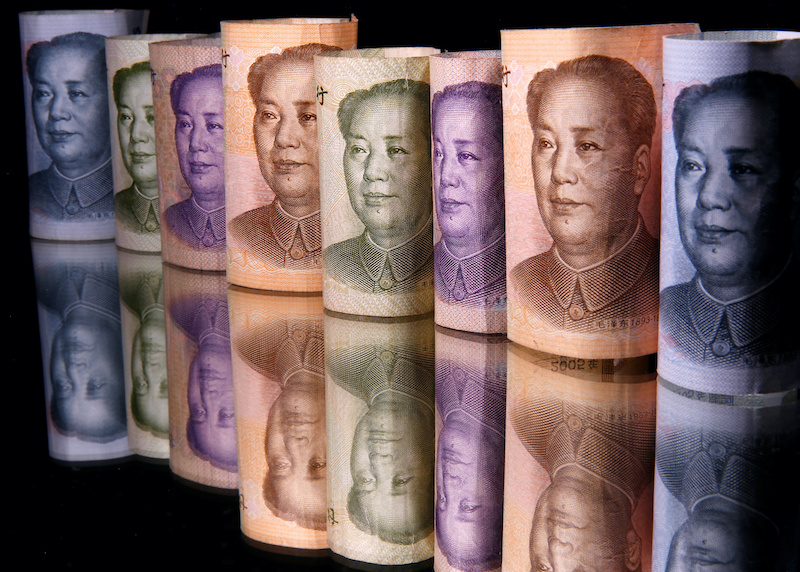China’s yuan slumped on Friday to its weakest level against the dollar since the 2008 financial crisis, despite efforts by state banks to stabilise the currency.
Major Chinese state banks were selling dollars in onshore foreign exchange market in a bid to stabilise the yuan while the country’s leaders were winding up the Communist Party’s 20th congress.
But the onshore yuan finished the domestic trading session down 0.46% on the day at 7.2494 per dollar, the weakest close since January 14, 2008.
For the week, it looked set to fall 0.78% as the surging dollar continued to batter emerging market currencies, taking its depreciation so far this year to 12.3%.
Traders said yuan weakness may persist, given broad dollar strength as US Federal Reserve officials show no signs of backing down from their hawkish rhetoric on rate hikes, while Chinese policymakers are struggling to support a faltering economy.
ALSO SEE:
China Delays Release of GDP Data During CCP Congress
Stability Sought Amid Congress
Earlier in the day banking sources said the dollar selling sought to prevent the spot yuan from breaching the key 7.25 per dollar level, as the local unit was weakening towards its daily downside limit.
On Monday too, state banks were spotted swapping yuan for US dollars in the forwards market and selling those dollars in the spot market, sources said.
State banks usually trade on behalf of the central bank in China’s foreign exchange market, but they can also trade for their own purposes or execute orders for corporate clients.
The banks’ actions were meant to stabilise the market given the importance placed on stability for the key event. The bank sources declined to be identified as they were not authorised to speak on the matter.
Prior to the market opening on Friday, the People’s Bank of China (PBOC) set the midpoint rate at 7.1186 per dollar, 2 pips firmer than the previous fix 7.1188.
The stronger daily guidance, which allows the onshore yuan to trade in a narrow range of 2% on either side of the midpoint, has effectively capped the downside limit for the yuan, a trader at a foreign bank said.
Friday’s fixing allowed the onshore yuan to trade in a range of 6.9762 to 7.2610, and the midday price was less than 0.2% away from hitting the lower end of the trading band.
“The USD/CNH-USD/CNY premium could be widening more persistently given the strong fixing bias that caps the onshore,” analysts at Maybank said in a note.
“Such signs of depreciation pressure could also spill over to regional EM FX,” they said, noting Friday marked the 13th straight session that the PBOC had set an “almost flat” midpoint guidance.
The offshore yuan, which trades more freely to reflect market expectations, was trading at 7.2721 per dollar around 0830 GMT.
EM Currencies Down Again
Emerging market (EM) currencies headed for their second straight weekly loss on Friday as the US dollar soared on heightened expectations of more US interest rate rises, while regional stocks extended losses for a third straight session.
The MSCI’s index for EM currencies slipped 0.3%, while stocks slid 0.5%.
Central and eastern European currencies outperformed many of their EM peers, with the Hungarian forint up 1.1% this week against the euro following last week’s emergency rate increase.
On Friday, the dollar index advanced 0.3% against a basket of major currencies, as US Treasury yields climbed to new multi-year peaks amid bets of an aggressive Federal Reserve rate path.
Meanwhile, China’s blue-chip CSI 300 Index edged 0.3% lower, posting its worst week in over a month, as investors cautiously awaited policy signals from the ongoing Communist Party Congress.
China’s property shares jumped after state media said authorities would ease share financing rules for certain real estate-related firms, fuelling hopes of more measures to aid the struggling sector.
- Reuters with additional editing by Jim Pollard
NOTE: This report was updated with further details and the headline changed on October 21, 2022.
ALSO SEE:
‘Huge’ Dollar Buying by China State Banks to Bolster Yuan
We Will Never Rule Out Using Force on Taiwan: Xi Jinping
China Says Stabilising Yuan is Priority, After Record Low
China to Lift FX Reserve Ratio, to Slow Yuan Plunge
























